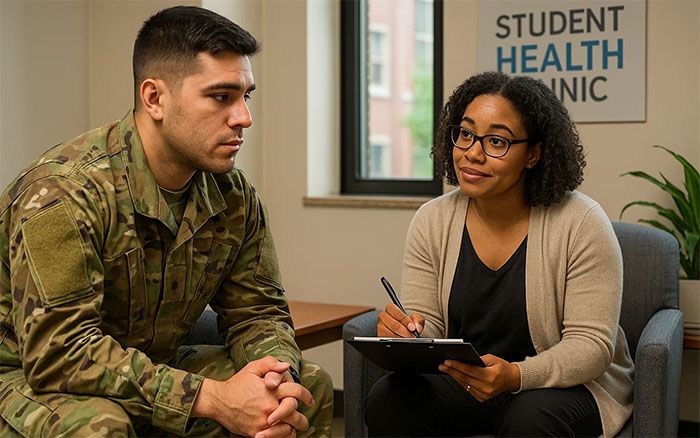How Colleges Can Support Native American Students on Campus
Enrollment among American Indian and Alaska Native (AIAN) students in higher education has declined sharply—nearly 40% between 2010 and 2021, according to the National Center for Education Statistics. Even more concerning, only 16% of AIAN adults over the age of 25 hold a college degree, compared to 30% across other racial and ethnic groups.
This widening gap highlights the need for stronger, culturally grounded systems that help Native students access, persist in, and complete college. In this blog, we outline how institutions can foster environments where Native American students feel supported and empowered throughout their college experience.
1. Support and Strengthen Native American Student Organizations
Native American students make up only about 1% of the U.S. college population. This stresses the importance of creating a welcoming and supportive campus culture.
One way colleges can address this is by supporting the formation and growth of Native American student organizations. Native student organizations play a vital role in fostering belonging and cultural pride by creating spaces where students can share experiences, celebrate heritage, and find community.
These organizations do more than host cultural events. They promote resilience, advocacy, and cross-cultural understanding through workshops, mentorship, and peer-led initiatives. When institutions actively invest in Native student organizations, they strengthen the foundation for belonging, leadership, and student success.
Furthermore, strengthening these organizations also benefits the wider campus community by increasing cultural awareness and promoting inclusivity.
2. Create Safe, Stigma-Free Spaces for Belonging and Wellness
Supporting Native students’ well-being requires more than access to your campus counseling center. Your campus can strengthen support for Native students by ensuring that every part of campus feels safe, inclusive, and affirming.
For Native students, finding belonging on campus can be especially complex. Many face experiences of isolation or discrimination that erode their sense of connection. Research shows that nearly one in five Native American youth (18.8%) report frequent exposure to racial trauma, and Indigenous adults experience suicidal thoughts at nearly twice the national rate. These realities underscore the need for campuses to create spaces that foster cultural affirmation and healing.
Practical strategies might include:
- Offering cultural visibility through art, language, and land acknowledgment in student spaces.
- Training faculty and staff to recognize racial trauma and respond with empathy and care.
- Partnering with Native student leaders to design inclusive events that celebrate identity and build community.
True belonging transforms campus life into a place where Native students—and all students—can thrive.
3. A Model in Action: University of Arizona’s Native American Student Affairs Program
A powerful example of culturally grounded student support can be found at the University of Arizona’s Native American Student Affairs (NASA) program. Established in 1989, NASA demonstrates how intentional design and partnership can transform the Native student experience on a large campus.
NASA provides a holistic network of academic and emotional support, including dedicated advisors, study lounges, emergency funding, and access to an embedded mental health counselor.
Beyond direct services, NASA integrates cultural recognition into the institution’s daily life. The program honors the Tohono O’odham Nation and Pascua Yaqui Tribe, weaving land acknowledgment and tribal sovereignty into events, partnerships, and campus communications. These actions exemplify how campuses can move from intent to impact in supporting Indigenous students.
4. Recruit and Support Native Faculty and Staff
Additionally, representation within faculty and staff can also play a defining role in whether Native students feel they belong on campus. Hiring and retaining Native educators and professionals provides students with mentors who understand their cultural context, lived experiences, and the unique pressures of navigating higher education.
When students see Native leaders in teaching, advising, and administrative roles, it reinforces that their perspectives matter—and that their futures in academia and leadership are possible.
Beyond visibility, Native faculty and staff also bring valuable knowledge to curriculum development, community engagement, and research partnerships that honor Indigenous traditions and values.
To strengthen representation, institutions can:
- Partner with tribal colleges and Native-serving organizations to strengthen pathways for Indigenous student and staff recruitment.
- Create mentorship and professional development programs that support the retention and growth of Native employees.
- Acknowledge and support the additional mentoring and advising contributions made by Native faculty and staff.
Creating space for Native professionals to lead, teach, and influence policy signals that Indigenous inclusion isn’t symbolic—it’s structural.
5. Build Institutional Infrastructure for Indigenous Support
Sustainable progress for Native students depends on systems—not just programs. Building institutional infrastructure ensures that Indigenous inclusion and belonging are part of a college’s foundation, not a short-term initiative.
Effective infrastructure includes:
- Dedicated leadership: Establish an Office of Indigenous Affairs, a Native Student Success Center, or a director-level liaison who can coordinate across departments.
- Cross-campus collaboration: Form advisory councils or task forces that bring together student affairs, academic units, counseling, and tribal partners to align goals and share data.
- Policy integration: Incorporate Native perspectives into institutional strategic plans, DEI frameworks, and campus-climate assessments to keep inclusion measurable and visible.
- Sustainable funding: Provide permanent budgets and staff lines for Indigenous programs and student support, rather than relying solely on grants or one-time allocations.
- Community partnerships: Build reciprocal relationships with local tribal nations and Native-serving organizations to ensure campus initiatives reflect community priorities.
When Indigenous inclusion is built into the institution’s structure—from leadership roles to funding models—it signals that Native student success is not just an initiative, but a lasting commitment. This foundation turns good intentions into lasting impact, ensuring that belonging and equity are woven into the fabric of campus life.
Key Takeaways
Supporting Native American students requires more than acknowledgment—it takes intentional action. By investing in culturally grounded student organizations, recruiting Native faculty and staff, and embedding Indigenous perspectives into campus culture, colleges can create environments where Native students truly belong.
When institutions pair these efforts with accessible, culturally informed wellness resources, they not only strengthen student success but also enrich the entire campus community.
Looking to improve how your campus connects students with care and wellness resources? See how Medicat can help your team support every student’s well-being.
















